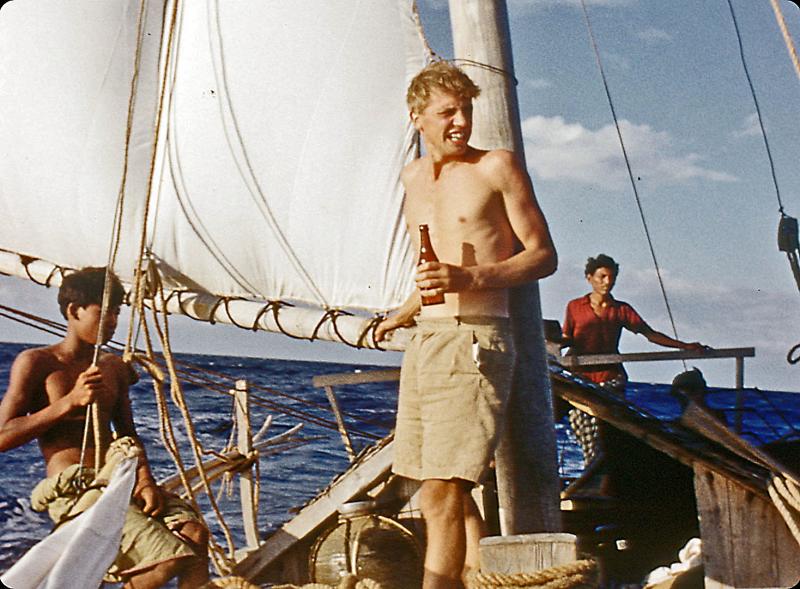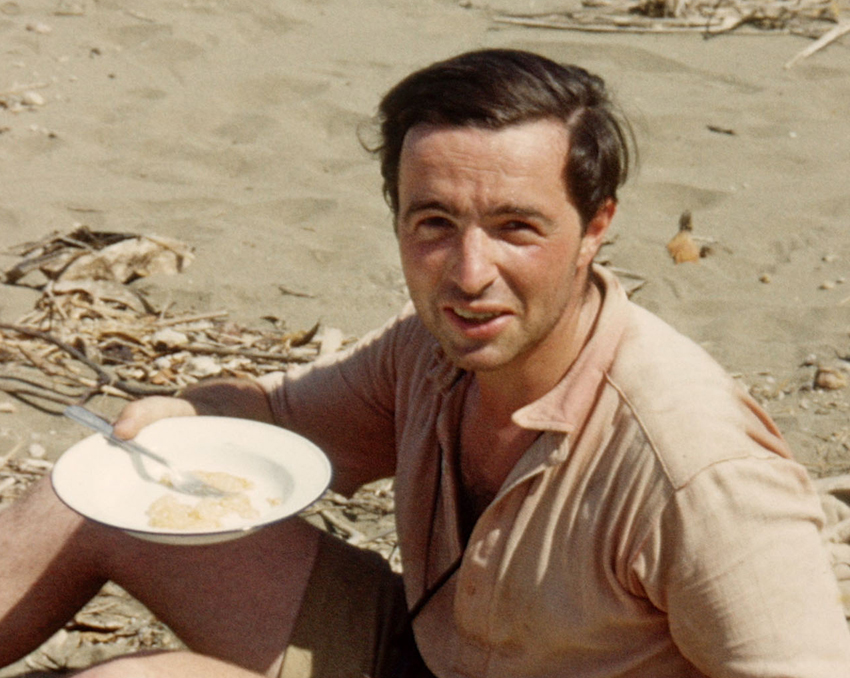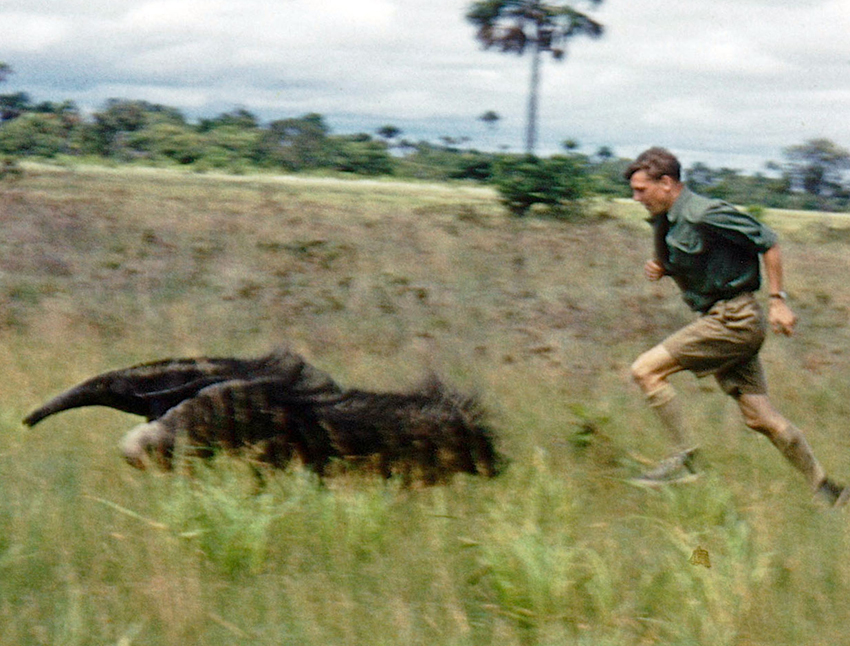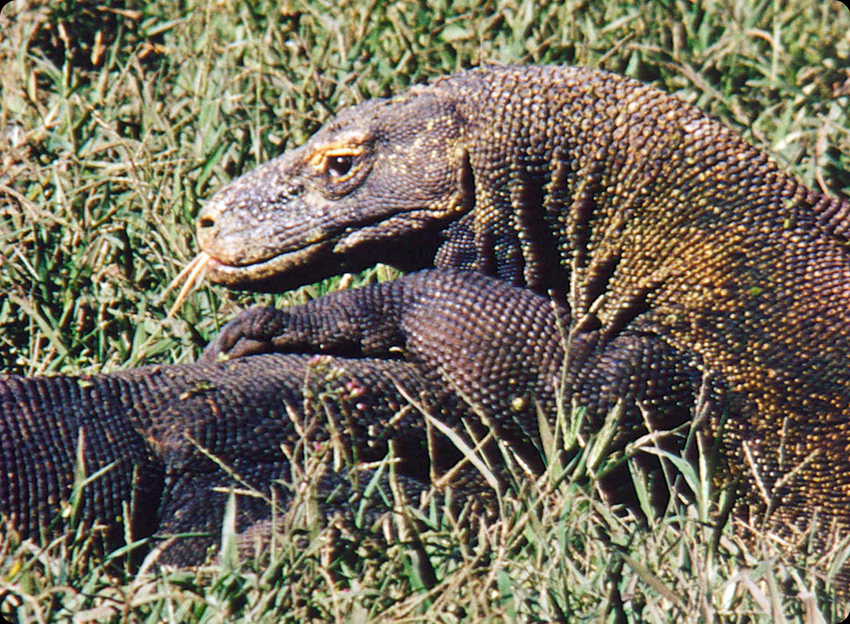David Attenborough's Zoo Quest in Colour, BBC Four | reviews, news & interviews
David Attenborough's Zoo Quest in Colour, BBC Four
David Attenborough's Zoo Quest in Colour, BBC Four
Amazing archive film from the pioneer days of wildlife film-making

What larks! The first run of Zoo Quest – itself the first of the wildlife programmes – started 62 years ago, in 1954. It was thought it had all been filmed in black and white, on small 16mm cameras, but in fact a condition imposed by the BBC was to shoot in colour to produce a sharper image in black and white. Discovered in the archives a few months ago were perfectly preserved canisters of colour film, six hours' worth in all.
So, perfectly timed for Attenbourgh's 90th birthday, the story of Zoo Quest was retold in this affectionate culling of extraordinary imagery of bygone days. Protocols for observing wildlife and conservation are now all quite different from the time when, as David Attenborough told us, two twentysomething young men and their team just set off into – for Westerners – the unknown.
 Attenborough was joined by Jack Lester, head of the reptile house at London Zoo, and a gifted cameraman, Charles Lagus (pictured right), who was to become Attenborough’s lifelong friend. The search for animals became almost by default a fascinating exercise in contemporary anthropology as village life and times, festivals and rituals were also filmed. Attenborough’s quarter-inch tape, battery-driven, recorded music made with drums and great wood and ivory wind instruments, accompanying coming-of-age dances.
Attenborough was joined by Jack Lester, head of the reptile house at London Zoo, and a gifted cameraman, Charles Lagus (pictured right), who was to become Attenborough’s lifelong friend. The search for animals became almost by default a fascinating exercise in contemporary anthropology as village life and times, festivals and rituals were also filmed. Attenborough’s quarter-inch tape, battery-driven, recorded music made with drums and great wood and ivory wind instruments, accompanying coming-of-age dances.
By plane, seaplane, jeep, dugout canoe, fishing boat, horseback and on foot our intrepid team explored, finding both societies and animals never before filmed by Westerners. First stop was Sierra Leone, where friendly villagers pointed out the Weaver birds who had made their amazing woven nests in a local tree. They'd stripped it totally of leaves, but they were never removed because they were regarded as ensuring prosperity to the village. A baby mongoose, a baby antelope, a baby owl and a baby ground squirrel all turned up, with pride of place to Jane the baby chimpanzee, and all were brought back to London.
 Onward to British Guiana in 1955, the river a tunnel of sunshine cutting through the jungle, and humidity and rain threatening the film stock with fungus and mildew; the clumsiness of the equipment then as compared to now was apparent. Here pet parrots sat on the rooftops; gorgeous young women painstakingly made flour from cassava, taking care to make sure the natural prussic acid in the root plant was pounded out.
Onward to British Guiana in 1955, the river a tunnel of sunshine cutting through the jungle, and humidity and rain threatening the film stock with fungus and mildew; the clumsiness of the equipment then as compared to now was apparent. Here pet parrots sat on the rooftops; gorgeous young women painstakingly made flour from cassava, taking care to make sure the natural prussic acid in the root plant was pounded out.
The village pets here were the biggest rodents in existence, two furry capabara, who went for frequent swims in the river with two cheeky and charming young boys, who also demonstrated how to use blowpipes. There was hilarious footage of the Brits chasing an impressive and graceful Giant Anteater, which was eventually brought down by lasso (Attenborough in pursuit of anteater, above).
In 1956 the goal was Indonesia: Borneo, Java, Sulawesi, Bali and the remote island of Komodo, home to the huge lizard known as the Komodo dragon. At the Buddhist temples of Borobudur, we witnessed a Hindu dance with young monks in a drugged trance, and watched eight-year-old girls performing elaborate temple dances. Gamelan music was heard for the first time. Attenborough had by now morphed into the presenter as well as the producer. In Java, he rather clumsily caught a python, while Charles Lagus bottle-fed a baby bear that he brought back to London. It lived in his flat for a while, and he took it for walks with collar and lead.
 We ended with a rather alarming adventure, as the BBC set off from Bali in a ramshackle fishing boat on what turned out to be a three-week voyage through storm and sun, with a disreputable captain who was evidently lost. They had only boiled rice to eat as the crew were unable to catch any fish, and their limited supply of tepid water was infested with mosquitoes. When they did fortuitously reach Komodo, the captain was revealed by the villagers as a gun-runner. Nonetheless the team managed to find the Komodo dragon (pictured above), and trapped one to bring back to the zoo.
We ended with a rather alarming adventure, as the BBC set off from Bali in a ramshackle fishing boat on what turned out to be a three-week voyage through storm and sun, with a disreputable captain who was evidently lost. They had only boiled rice to eat as the crew were unable to catch any fish, and their limited supply of tepid water was infested with mosquitoes. When they did fortuitously reach Komodo, the captain was revealed by the villagers as a gun-runner. Nonetheless the team managed to find the Komodo dragon (pictured above), and trapped one to bring back to the zoo.
The vintage film was interleaved with anecdotes from Attenborough and Lagus, now nonagenerians both. There was some rueful acknowledgment by Attenborough of the BBC's bureaucratic tendencies even then, as well as a genial amazement at the way these two broadcasting youngsters were given their freedom to explore the natural world on three different continents. And the digitally enhanced colour of the newly found film was just gorgeous, a discovery to treasure.
The future of Arts Journalism
You can stop theartsdesk.com closing!
We urgently need financing to survive. Our fundraising drive has thus far raised £49,000 but we need to reach £100,000 or we will be forced to close. Please contribute here: https://gofund.me/c3f6033d
And if you can forward this information to anyone who might assist, we’d be grateful.

Subscribe to theartsdesk.com
Thank you for continuing to read our work on theartsdesk.com. For unlimited access to every article in its entirety, including our archive of more than 15,000 pieces, we're asking for £5 per month or £40 per year. We feel it's a very good deal, and hope you do too.
To take a subscription now simply click here.
And if you're looking for that extra gift for a friend or family member, why not treat them to a theartsdesk.com gift subscription?
more TV
 Mr Scorsese, Apple TV review - perfectly pitched documentary series with fascinating insights
Rebecca Miller musters a stellar roster of articulate talking heads for this thorough portrait
Mr Scorsese, Apple TV review - perfectly pitched documentary series with fascinating insights
Rebecca Miller musters a stellar roster of articulate talking heads for this thorough portrait
 Down Cemetery Road, Apple TV review - wit, grit and a twisty plot, plus Emma Thompson on top form
Mick Herron's female private investigator gets a stellar adaptation
Down Cemetery Road, Apple TV review - wit, grit and a twisty plot, plus Emma Thompson on top form
Mick Herron's female private investigator gets a stellar adaptation
 theartsdesk Q&A: director Stefano Sollima on the relevance of true crime story 'The Monster of Florence'
The director of hit TV series 'Gomorrah' examines another dark dimension of Italian culture
theartsdesk Q&A: director Stefano Sollima on the relevance of true crime story 'The Monster of Florence'
The director of hit TV series 'Gomorrah' examines another dark dimension of Italian culture
 The Monster of Florence, Netflix review - dramatisation of notorious Italian serial killer mystery
Director Stefano Sollima's four-parter makes gruelling viewing
The Monster of Florence, Netflix review - dramatisation of notorious Italian serial killer mystery
Director Stefano Sollima's four-parter makes gruelling viewing
 The Diplomat, Season 3, Netflix review - Ambassador Kate Wyler becomes America's Second Lady
Soapy transatlantic political drama keeps the Special Relationship alive
The Diplomat, Season 3, Netflix review - Ambassador Kate Wyler becomes America's Second Lady
Soapy transatlantic political drama keeps the Special Relationship alive
 The Perfect Neighbor, Netflix review - Florida found-footage documentary is a harrowing watch
Sundance winner chronicles a death that should have been prevented
The Perfect Neighbor, Netflix review - Florida found-footage documentary is a harrowing watch
Sundance winner chronicles a death that should have been prevented
 Murder Before Evensong, Acorn TV review - death comes to the picturesque village of Champton
The Rev Richard Coles's sleuthing cleric hits the screen
Murder Before Evensong, Acorn TV review - death comes to the picturesque village of Champton
The Rev Richard Coles's sleuthing cleric hits the screen
 Black Rabbit, Netflix review - grime and punishment in New York City
Jude Law and Jason Bateman tread the thin line between love and hate
Black Rabbit, Netflix review - grime and punishment in New York City
Jude Law and Jason Bateman tread the thin line between love and hate
 The Hack, ITV review - plodding anatomy of twin UK scandals
Jack Thorne's skill can't disguise the bagginess of his double-headed material
The Hack, ITV review - plodding anatomy of twin UK scandals
Jack Thorne's skill can't disguise the bagginess of his double-headed material
 Slow Horses, Series 5, Apple TV+ review - terror, trauma and impeccable comic timing
Jackson Lamb's band of MI5 misfits continues to fascinate and amuse
Slow Horses, Series 5, Apple TV+ review - terror, trauma and impeccable comic timing
Jackson Lamb's band of MI5 misfits continues to fascinate and amuse
 Coldwater, ITV1 review - horror and black comedy in the Highlands
Superb cast lights up David Ireland's cunning thriller
Coldwater, ITV1 review - horror and black comedy in the Highlands
Superb cast lights up David Ireland's cunning thriller
 Blu-ray: The Sweeney - Series One
Influential and entertaining 1970s police drama, handsomely restored
Blu-ray: The Sweeney - Series One
Influential and entertaining 1970s police drama, handsomely restored

Add comment